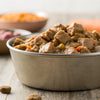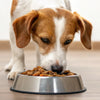Should Dogs Eat Dry Food or Wet Food? A Comprehensive Guide for Pet Owners
- Houndsy
Table of Contents
- Introduction
- Understanding Dog Food: Dry vs. Wet
- Pros and Cons of Each Type of Dog Food
- Mixing Wet and Dry Dog Food
- Choosing the Right Option for Your Dog
- Houndsy’s Role in Enhancing Feeding Experience
- Conclusion
Introduction
As pet owners, we often find ourselves pondering one of the most fundamental questions about our furry companions: should dogs eat dry food or wet food? According to a survey conducted by the American Kennel Club, nearly 60% of dog owners consider their dog's diet to be one of the most important factors in pet care (American Kennel Club, 2023). With the abundance of options available on the market today, it can be overwhelming to choose the right diet that not only meets our pets' nutritional needs but also aligns with our lifestyle.
In this blog post, we aim to address this pressing dilemma by exploring the differences, benefits, and drawbacks of both dry and wet dog food. We will also discuss the importance of consulting with a veterinarian to tailor your dog’s diet to its specific needs. By the end of this article, we hope to equip you with a better understanding of the feeding options available and help you make an informed choice for your beloved pet.
We will delve into the nutritional profiles of both wet and dry food, examine their effects on dogs' health, and discuss factors to consider when making a decision. Additionally, we invite you to reflect on your own pet's feeding routine, encouraging you to think critically about how to best cater to their dietary preferences and lifestyle.
Understanding Dog Food: Dry vs. Wet
What is Dry Dog Food?
Dry dog food, often referred to as kibble, is typically composed of a mixture of meat, grains, vegetables, and added vitamins and minerals. It has undergone a specific manufacturing process that involves cooking ingredients into a doughy consistency, which is then extruded into the small, crunchy kibble shapes we recognize.
Nutritional Advantages of Dry Dog Food:
- Dental Health: The crunchy texture encourages chewing, which may help remove plaque and tartar buildup, promoting better dental hygiene.
- Convenience: Kibble can be easily portioned, stored, and left out without concern for spoilage. Unlike wet food, it also doesn’t require refrigeration.
- Cost-Effective: Dry food tends to be less expensive on average compared to wet food, especially when purchased in bulk.
- Longer Shelf Life: An unopened bag of dry dog food can last for months without losing its nutritional integrity.
What is Wet Dog Food?
Wet dog food, commonly available in cans or pouches, consists mainly of meat, water, and often additional ingredients to boost nutritional value. The high moisture content—typically ranging from 75% to 84%—makes it a popular option for increasing hydration levels among dogs.
Nutritional Advantages of Wet Dog Food:
- Enhanced Palatability: The smell and taste of wet food can be more appealing to dogs, encouraging even pickiest eaters to enjoy their meals.
- Hydration Boost: The added moisture can be beneficial for dogs that don’t drink enough water, particularly for those with kidney issues or urinary tract problems.
- Softness Makes Eating Easier: Dogs with dental diseases or older dogs with missing teeth may find it easier to eat wet food that doesn’t require as much chewing.
Pros and Cons of Each Type of Dog Food
Benefits of Dry Dog Food
-
Self-Serve Convenience:
- Dry food can be provided in a free-feeding style, allowing dogs to graze as they please.
-
Easier Portion Control:
- We can accurately measure kibble servings, which aids in calorie tracking and weight management.
-
Longer Meal Times:
- Chewing dry food may extend mealtime, which can contribute to a satisfying eating experience.
-
Less Mess:
- Kibble tends to stay cleaner both in the bowl and on your dog's face, making cleanup simpler.
Drawbacks of Dry Dog Food
-
Lower Moisture Content:
- Dry foods do not provide hydration benefits and may lead to dehydration in more susceptible dogs.
-
Potential for Weight Gain:
- The convenience of free-feeding could lead to overeating, especially in less active dogs.
-
Less Appealing for Picky Eaters:
- Some dogs might turn away from dry kibble, leading to a less nutritious diet if they refuse to eat.
Benefits of Wet Dog Food
-
Boosting Hydration:
- Wet food’s moisture content helps dogs with hydration, particularly if they are less inclined to drink water.
-
Appealing Aroma and Flavor:
- The rich, meaty smell can entice dogs, making it a better option for those with decreased appetites.
-
Great for Sensitive Stomachs:
- Wet food is often easier for dogs with digestive issues to digest compared to dry kibble.
Drawbacks of Wet Dog Food
-
Higher Cost:
- Wet food can be pricier over time, particularly if fed regularly.
-
Shorter Shelf Life:
- Once opened, wet food must be refrigerated and used within a few days, limiting its convenience.
-
Potential for Mess:
- Wet food can create messier eating experiences, often resulting in food particles stuck in your dog's fur.
Mixing Wet and Dry Dog Food
For those pet parents unsure about choosing one over the other, mixing wet and dry dog food is a popular approach. It allows us to combine the benefits of both types while catering to our dogs' tastes and nutritional needs.
Advantages of Mixing
-
Increased Palatability:
- Mixing two types of food can enhance the overall flavor profile, making meals more exciting for your dog.
-
Improved Digestive Health:
- Combining the fiber from dry food with the moisture from wet food can promote better digestion and hydration.
-
Catering to Specific Needs:
- For senior dogs or those with dental issues, mixing wet food with dry kibble can make mealtime easier and more enjoyable.
Considerations When Mixing
- Caloric Balance: When mixing, it is crucial to account for the total caloric intake to avoid overfeeding.
- Introduce Gradually: As with any dietary change, mixing should be introduced gradually over five to ten days to ensure your dog adjusts well.
- Consult with Your Veterinarian: Always check with your veterinarian before making significant changes to your dog’s diet to determine the best options tailored for their health.
Choosing the Right Option for Your Dog
In deciding whether your dog should eat dry food or wet food, or a combination of both, consider several important factors:
1. Age and Health
Puppies may benefit from softer wet food during transitions from mother’s milk, while senior dogs with dental issues may find wet food easier to chew. Conversely, active adult dogs might thrive on the dental health benefits of dry kibble.
2. Activity Level
High-energy dogs might appreciate the crunch and convenience of kibble, while dogs that are less active may benefit from the hydration provided by wet food.
3. Picky Eaters
For dogs that are fussy about food, starting with wet food or mixing wet with dry can encourage them to finish their meals.
4. Lifestyle and Convenience
For busy pet parents, dry kibble may offer greater convenience with its longer shelf life, easy storage, and cleaner serving methods.
5. Personal Preference
Ultimately, our dogs’ preferences should also be taken into consideration. Observing how they respond to different food types can guide our decisions.
Houndsy’s Role in Enhancing Feeding Experience
At Houndsy, we strive to simplify and elevate the everyday feeding experiences of pet owners through innovative design. Our flagship product, the Houndsy Kibble Dispenser, makes feeding hassle-free with its convenient crank at standing height, enabling you to serve perfect portions of kibble without bending down.
By using our thoughtfully designed, mid-century modern Houndsy Kibble Dispenser, you can enhance the aesthetics of your home while ensuring that your pet enjoys a consistent and delightful feeding routine. With features such as a large storage capacity, a BPA-free liner for freshness, and an auto-locking mechanism, our product brilliantly marries form with function, making it an ideal choice for design-conscious pet parents.
Conclusion
In conclusion, whether dogs should eat dry food or wet food ultimately depends on individual dietary needs, preferences, and lifestyle considerations. Both options offer unique advantages and disadvantages that can cater to different dogs at various life stages. It’s crucial to carefully evaluate your pet's situation and consult with a veterinarian for personalized advice on the best diet.
As we continue to explore the optimal feeding solutions for our canine companions, we invite you to consider how the Houndsy Kibble Dispenser can simplify your dog feeding experience while enriching your pet's daily life.
FAQ
1. Can I mix wet and dry dog food? Yes, mixing dry and wet dog food can provide the benefits of both and make meals more appealing for your dog. Just ensure you monitor your dog's total caloric intake.
2. Which is better for dogs with dental issues? Wet dog food is often easier for dogs with dental issues to consume. However, a balanced diet that includes dry food can also help with dental hygiene by encouraging chewing.
3. Is wet food more nutritious than dry food? Both wet and dry dog food can be nutritionally complete if made by reputable brands. However, wet food typically contains a higher moisture content, while dry food is denser in calories.
4. How can I lure my dog to eat if they refuse food? If your dog is being fussy, try offering wet food, mixing it with dry kibble, or gradually introducing different flavors and textures to see what they enjoy.
5. How should I store opened wet dog food? Once opened, wet dog food should be refrigerated and used within a few days to maintain freshness.
By caring for our dogs and providing them with a nutritious diet, we can help them lead happy and healthy lives. The decision of whether to go dry or wet, or a little of both, is up to us as empowered pet parents.












